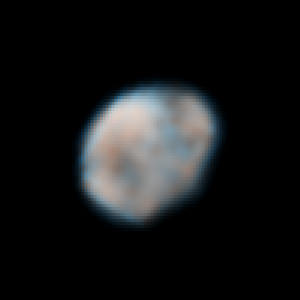[/caption]The largest asteroid in the Solar System is 4 Vesta. Ceres is much more massive, but has been promoted to dwarf planet status, leaving Vesta the largest asteroid. Ceres and Vesta will be orbited and studied by the Dawn spacecraft.
Vesta was first discovered on March 29, 1807 by Heinrich Wilhelm Olbers. The asteroid measures 578 km by 458 km and has a mass of 2.67 x 1020 kg. It has a magnitude of +5.4 to +8.5 and can be easily observed with binoculars on a clear night. It has been seen with the unaided eye on several occasions. Vesta rotates on its axis every 5.342 hours and has an axial tilt of 29º. Temperatures on the surface range from a frigid -188ºC (85 K) to -18ºC (255 K). Hubble images have revealed ancient lava flows. This is a direct contradiction of the belief that asteroids are simple cold, dead rocks floating in space. There is a gigantic impact basin so deep that it exposes the asteroid’s mantle at the South pole. The mantle is thought to be 10 km below the asteroid’s surface.
Several NASA scientists have concluded that Vesta is the parent body of many meteorites. That means that we have parts of only five celestial bodies here on Earth: Earth(obviously), the Moon, Mars, Vesta, and the comet Wild 2. Vesta is the parent body of the eucrite meteorite group. The group formed approximately 4.56 billion years ago. Many of them metamorphosed to temperatures up to 800° C and were brecciated and heated by large impacts into the parent body surface. The less common basaltic, unbrecciated eucrites also formed near the surface, but presumably escaped later brecciation. The cumulate eucrites formed at a depth where metamorphism may have persisted for an undetermined amount of time. These meteorites may have originated from the large impact at the south pole of the asteroid.
The Dawn mission is designed to be the first spacecraft to orbit two non-Earth objects. It arrived in orbit around Vesta on July 15, 2011. It will study the largest asteroid in the Solar System for about a year before leaving orbit for Ceres in 2012. Vesta was chosen as a destination because of its unique qualities. It accounts for 9% of the mass in the main asteroid belt and it is an evolved object(has a mantle, core, and crust). NASA scientists fully expect to make several interesting discoveries from the study of Vesta. Be sure to check back later for updates.
Here’s an article about how Vesta formed fast and early in the Solar System, and some Hubble images of the asteroid.
Here’s more on Vesta from Solar Views, and some images from NASA.
We have recorded a whole series of podcasts about the Solar System at Astronomy Cast. Check them out here.
Sources:
http://research.jsc.nasa.gov/PDF/Ares-6.pdf
http://www.nasa.gov/multimedia/podcasting/jpl-cassini-20080428.html
http://www.nasa.gov/mission_pages/dawn/news/dawn20110716.html
http://www.nasa.gov/mission_pages/dawn/news/dawn20110329.html

